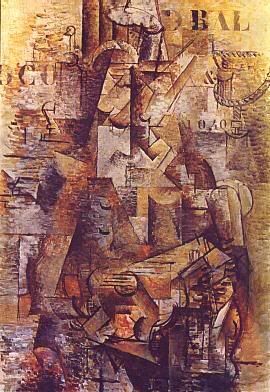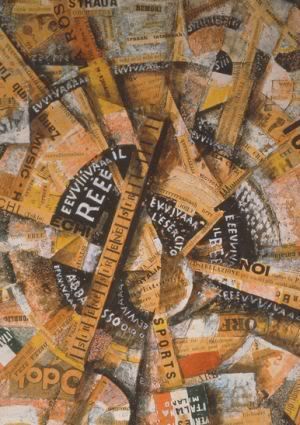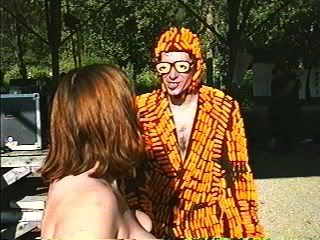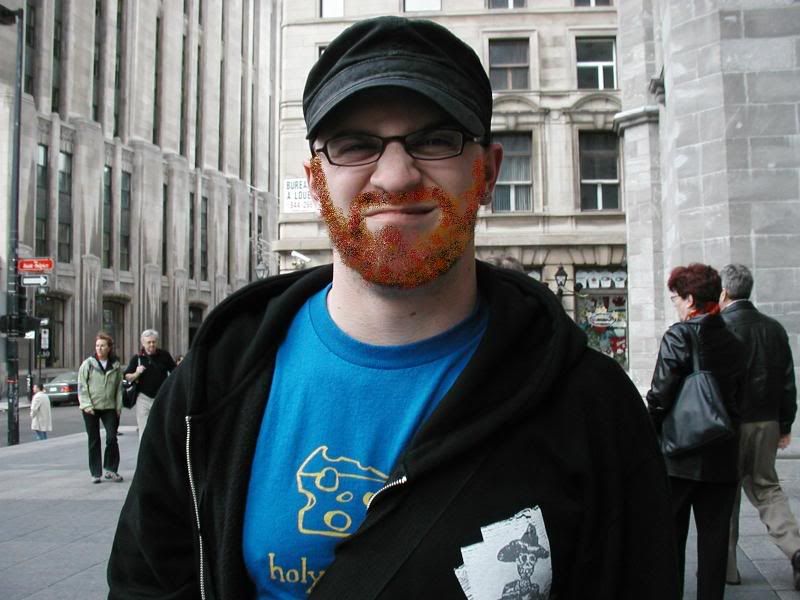Monday, October 30, 2006
Thursday, October 19, 2006
Futurism VS Analytical Cubism: TO THE DEATH.
Analytical Cubism’s Style & Futurism’s Manifestos
Throughout the history of art and all its movements it has been a common practice that each new movement borrows from the one that came before it. This continues to be true to this day, and Futurism appears to owe much to its predecessor and peer; Analytical Cubism. The Futurists and the Analytical Cubists were quite different fundamentally regarding their message and content, but shared many aspects visually and technically. The two main works that will be used as comparisons of the two styles in this essay are: The Portuguese (The Emigrant) by George Braque, created in 1911-12 (Fig.2) and Interventionist Demonstration by Carlo Carra created in 1914 (Fig. 1). These works are Analytical Cubist and Futurist respectively. Knowing that Carra’s work was created after Braque’s it appears possible that Carra borrowed some compositional ideas from Braque because of the apparent similarities of colour and composition. Despite the subject, media and political message being very different in both works, it is possible to see aesthetic similarities.
Cubism began in a somewhat clandestine way with a painting that was so well liked it remained on sale for 14 years in Paris in 1907, Lacroix (09/19/06). Picasso’s controversial Les Demoiselles d’Avignon (Fig. 7) was a catalyst, for both himself and for his friend George Braque, to explore a new way of painting that plunged the artists deeper into abstraction and history. It was not until 1911 that Braque and Picasso exploded Cubism into Analytical Cubism. Where Cubism transformed the everyday into simpler geometric forms with tilted perspectives, Analytical Cubism took Cubism a few steps farther and shattered the geometric forms into a meshwork of tilted planes like so much broken glass, the backgrounds and foregrounds paradoxically becoming one with no reliable source of light or vanishing point, Foster (2004). There are, of course, other differences between the two. The coming of Analytical Cubism would be the signal for a broad palette of colours to silently leave the studio. The monochromatic palette would have dominance in this period. This style of Cubism would also stress even farther than their painterly ancestors that the canvas was indeed flat. Any painting that was “three-dimensional” was just an illusion, meant to fool the eye, Foster (2004). The works of Braque at this time, like The Portuguese, had the many small tilted planes denying the viewer a proper perspective while still appearing three dimensional, but also had stenciled writing atop the tilted planes decrying those very same tilted planes, disrupting the illusion, Cottington (2004).
Crawling out of the cockpit of a sports car overturned in the ditch somewhere in
Thus from observation the Futurists learned and adopted Cubism, adapting it to their painting style and discarding the old methods which alluded to traditional styles of divisionism and impressionism. An example of an earlier Futurist attempt to add Cubist elements into their methodology is the 1910, Portrait of Marinetti by Carlo Carra (Fig. 3); though the work can by no means be considered Cubist it nevertheless represents a noticeable shift towards the tilted planes and geometry of Cubism, Lacroix (2006). That is not to say that Futurism was “stealing” these techniques; as mentioned earlier, artists will always borrow from one another and seek inspiration outside of themselves. This portrait helps to demonstrate where this new influence is coming from. In sculpture as well there is a clear borrowing of ideas in the comparison of Pablo Picasso’s Woman’s Head (1909) (Fig. 6) and Umberto Boccioni’s Antigrazioso (1912) (Fig. 5), Martin (1978). To give credit to the Futurists they did add their own elements to what they were borrowing. The dynamism, movement and the colours that the Futurists expressed was something not present in Cubism at the time. Analytical Cubism was about static images and still life. Boccioni’s Dynamism of a Cyclist (1913) (Fig. 4) uses a Cubist style but incorporates movement successfully into that abstraction.
If Futurism borrowed so much from Analytical Cubism and is so stylistically similar, why is it considered to be a different movement at all? The simplest answer would be politics. One definite difference between the two is how politically radical the Futurists were. Futurism was about antagonism, performance and the violence and energy of a public spectacle. Analytical Cubism was about exploring new paths in painting technique and experimenting with painterly illusions of depth and perspective. Breaking the subject into pieces to separate the foreground and the background; the subject from the setting, Cottington (2004). There was no political message in Braque’s The Portuguese, he was simply painting and experimenting with perception. The Portuguese may have a similar colour scheme of monochromatic brown and combine text on top of geometric shapes to Carra’s Interventionist Demonstration, but Carra’s work is almost that of propaganda; alluding to war, or at least a prophetic message of the war to come soon after. Braque hints at guitars and a street corner and the words he has stenciled suggest dancing. Carra has written in and cut and pasted the words, “Long Live the King! Long Live the Army!” and “Italia!” The German word for dead (tot) is also displayed in bold black capital letters a month before war with
From the time of their discovery of Cubism onwards, the Futurists walked the thin line between theft and flattery -- and it is hard to say on which side they ended up. They have not been overlooked in history, but they have not had the same influence in painting that the Analytical Cubists have had. Analytical Cubists would paint traditional subjects like nudes, still life and landscapes in a new and interesting way; Analytical Cubism was an aesthetic revolution. The Futurists would paint new exciting things like the automobile and forsake the nude. Unfortunately the Futurists would paint these modern subjects in a more traditional or less innovative way, but this is mostly because Futurism was more of an ideological revolution than one of aesthetics at its core. Perhaps the fact that Futurism was unable to live up to the ideals of its ambitiously violent manifesto detracted from the movement’s impact. It does seem as though the Futurists borrowed more from Analytical Cubism than they themselves were able to add to the forefront of artistic development. Instead it seems they succeeded in making a statement and causing controversy like the avant-garde should, which seems to have been one of their more important goals.
Cottington, D. (2004). Cubism and Its Histories.
Foster, H., Krauss, R., Bois, Y., Buchloh, B. (2004). Art Since 1900, Volume 1 1900 – 1944.
Kerrigan, M. (2005). Modern Art.
Lacroix, C. (2006) Class Notes from Art from 1900 to 1950.
Martin, M.W. (1978). Futurist Art & Theory 1909 – 1915.
Hopefully both images appear.


This just in. . . I GOT A 90% ON THIS ESSAY! EFFIN A MAN.
Monday, October 16, 2006
Gordo Queso
I will uncover that secret right now.
This is a secret I learned from one of my Mom's old douche-bag boyfriends. This guy was a serious loser BUTT he did know this fantasic secret that has made my life slightly fatter.
When you get chips or cheetos, put them in the freezer for awhile, I suggest overnight for maximum effects. The fat/grease in the chips (junk food item) will freeze, so when it comes in contact with your warm, taste bud covered tongue the frozen fat will explode in a savoury flavour eruption. Cheetos, the puff kind, have the most noticeable effect. Also original Ruffles are quite greasy and effective.
To demonstrate this sensation here is soem guy wearing cheetos advancing on a possibly topless woman. I can't really tell. And yes, I'm just as confused as you.
The interwub is a weird place.



